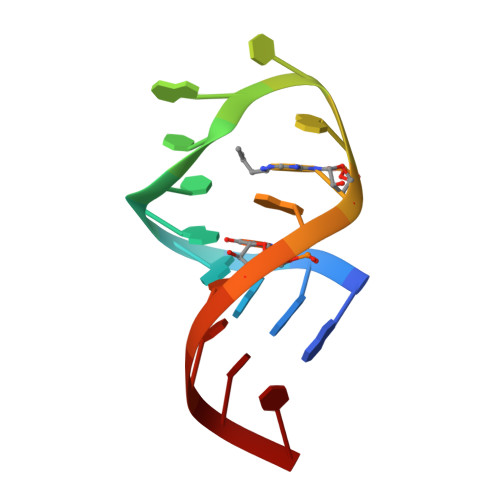Conformation Effects of Base Modification on the Anticodon Stem-Loop of Bacillus subtilis tRNA(Tyr).
Denmon, A.P., Wang, J., Nikonowicz, E.P.(2011) J Mol Biology 412: 285-303
- PubMed: 21782828
- DOI: https://doi.org/10.1016/j.jmb.2011.07.010
- Primary Citation of Related Structures:
2LA9, 2LAC, 2LBQ, 2LBR - PubMed Abstract:
tRNA molecules contain 93 chemically unique nucleotide base modifications that expand the chemical and biophysical diversity of RNA and contribute to the overall fitness of the cell. Nucleotide modifications of tRNA confer fidelity and efficiency to translation and are important in tRNA-dependent RNA-mediated regulatory processes. The three-dimensional structure of the anticodon is crucial to tRNA-mRNA specificity, and the diverse modifications of nucleotide bases in the anticodon region modulate this specificity. We have determined the solution structures and thermodynamic properties of Bacillus subtilis tRNA(Tyr) anticodon arms containing the natural base modifications N(6)-dimethylallyl adenine (i(6)A(37)) and pseudouridine (ψ(39)). UV melting and differential scanning calorimetry indicate that the modifications stabilize the stem and may enhance base stacking in the loop. The i(6)A(37) modification disrupts the hydrogen bond network of the unmodified anticodon loop including a C(32)-A(38)(+) base pair and an A(37)-U(33) base-base interaction. Although the i(6)A(37) modification increases the dynamic nature of the loop nucleotides, metal ion coordination reestablishes conformational homogeneity. Interestingly, the i(6)A(37) modification and Mg(2+) are sufficient to promote the U-turn fold of the anticodon loop of Escherichia coli tRNA(Phe), but these elements do not result in this signature feature of the anticodon loop in tRNA(Tyr).
- Department of Biochemistry and Cell Biology, Rice University, Houston, TX 77251-1892, USA.
Organizational Affiliation:
















